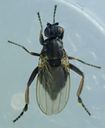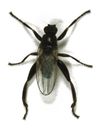Lesser Dung Flies
Sphaeroceridae
Classification
- Phylum: Arthropoda
- Subphylum: Hexapoda
- Class: Insecta
- Order: Diptera
- Superfamily: Sphaeroceroidea
- Family: Sphaeroceridae
Pronunciation
How to pronounce Sphaeroceridae: /sfɪəˌrɒsəˈraɪdiː/
These audio files are automatically generated. While they are not always 100% accurate, they are a good starting point.
Images






Summary
Sphaeroceridae, commonly known as lesser dung flies, are a family of small flies associated with decaying organic matter. They play a vital role in the nutrient cycle but are often unnoticed despite their abundance.
Physical Characteristics
Small to minute, usually dull-colored flies with characteristically thickened first tarsomere of the posterior leg. The first tarsal segment is less than 1.5 times as long as the second tarsal segment and dilated. The crossvein separating the second basal and discal cells is missing. Veins four and five often fade apically.
Identification Tips
Look for small flies with black wings and interrupted costa, and the characteristic thickened first tarsomere of the posterior leg.
Habitat
Associated with all kinds of sufficiently moist decaying organic matter, including manure, decaying plants, fungi, and seaweed.
Distribution
Worldwide except in regions with permanent ice-cover; ca. 280 species in 30 genera known north of Mexico as of 2000; worldwide approximately 1,600 species in about 140 genera.
Diet
Larvae feed on manure, decaying matter, seaweed, or fungi.
Life Cycle
Details about the life cycle are poorly known, but larvae are microbial grazers found in decomposing organic materials.
Reproduction
Some species are known to be parthenogenetic; details on reproduction are limited.
Predators
Sphaerocerids are prey for mites and beetles, which also feed on the immatures of muscoid flies, helping control problematic muscoid populations.
Ecosystem Role
Part of the nutrient cycle, associated with decaying organic matter; they are important components of the carrion-insect community.
Economic Impact
Little is known about their economic impact, but some species indicate poor hygiene and waste accumulation in food-processing plants.
Cultural Significance
They may act as indicators of blocked drains and waste accumulation in various environments; some species are involved in forensic entomology.
Health Concerns
They may carry pathogenic microorganisms and can present a public health hazard in certain conditions; some species have been implicated in human intestinal myiasis.
Collecting Methods
- Pan traps
- Light traps
Preservation Methods
- Ethanol preservation
- Pinned specimens
Evolution
Sphaeroceridae is part of the order Diptera, section Schizophora, and are closely related to Heleomyzidae within the superfamily Sphaeroceroidea.
Similar Taxa
Misconceptions
Few, if any, other insects are as common or as rarely noticed as sphaerocerids, leading to a lack of awareness of their ecological role.
Tags
- Lesser Dung Flies
- Sphaeroceridae
- Diptera
- Ecology